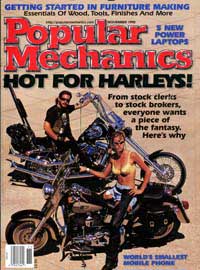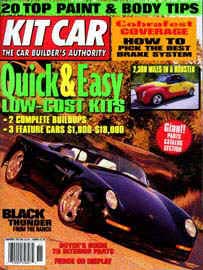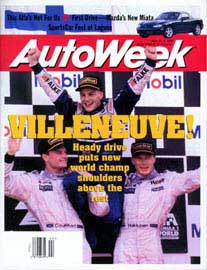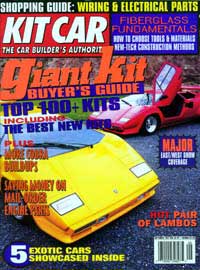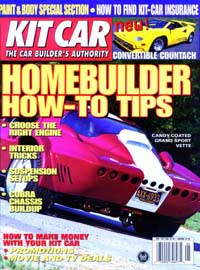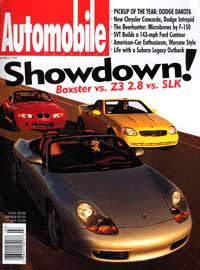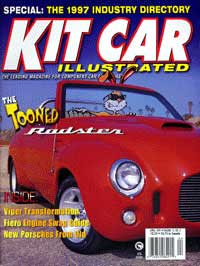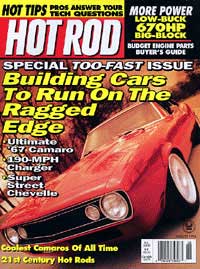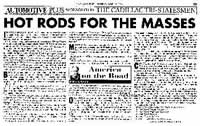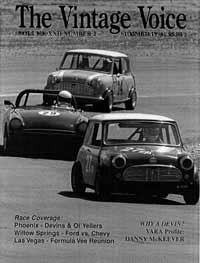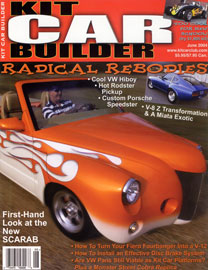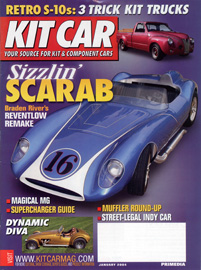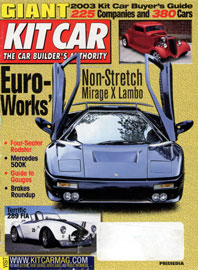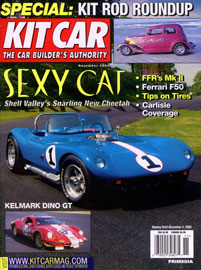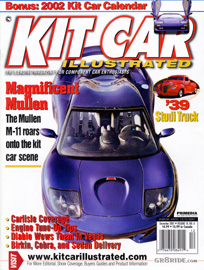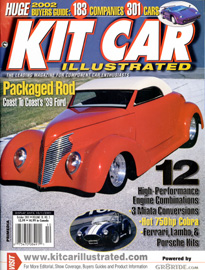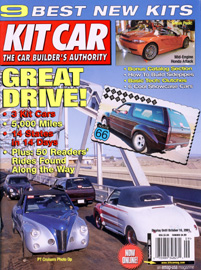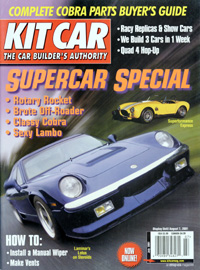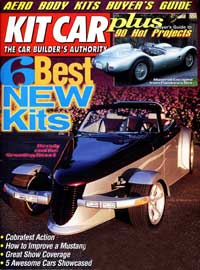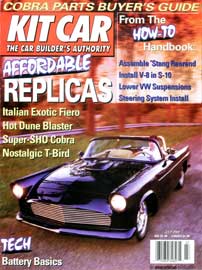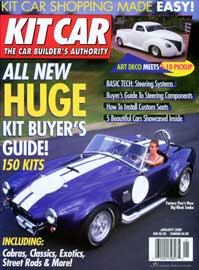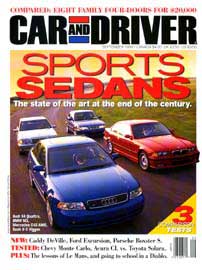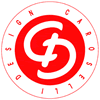What
is the Rodster®?
© Copyright Caroselli.
No images or text located anywhere on this site may be reused
or republished without expressed written permission from Rodster,
Inc., d.b.a.: Caroselli Design. The Rodster Street Rod design
is protected by
U.S. Patent # D450,284.
"Rodster®" is a registered
trademark of Caroselli Design. |
What is Kit Car Magazine saying about the Rodster® Street Rod?
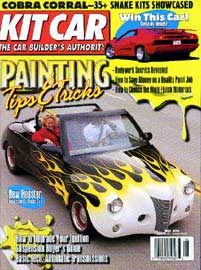 Kit
Car Magazine
Kit
Car Magazine
Highly Flammable
Familiar Fat-Fendered Fun in Caroselli Design's New Rodster
by Jim Youngs
Henry Caroselli set out to design a car that would offer an alternative to the ever-escalating prices street rods command to build and buy. He foresaw an easy build and a stylish, character-laden car that would not only turn heads, but would also be extremely affordable to put together, thus its owner would be more willing to drive it regularly. He felt that so many of the high-dollar street rods being built spend their lives serving as trailer queens or 100-mile vehicles (only driven 50 miles from home and 50 miles back), that the fun factor of the cars was virtually lost to the investment aspects. Henry, with the help of noted Art Center grad and designer Todd Gerstenberger, took a reverse engineering approach to the Rodster project, by starting with a modern platform and drivetrain, then fitting the parts with a retro body.
Though obscure as a donor vehicle, Henry wisely chose the GM ('83-'94 two-door Chevy S-10 Blazer/GMC S-15 Jimmy) mini SUV as the platform on which to build the Rodster. The logic of that choice was quite sound, since some 2.8 million of the little SUVs were produced, and a wealth of aftermarket components is available for them. The cars are plentiful and reasonably priced to use as donors for the Rodster rebody. There is also plenty of potential to make these cars potent performers. They were offered with a couple of modest four-bangers and a 4.3L V-6, but a lot of room intentionally exists under the flip-forward front clip to handily swallow a small-block V-8.

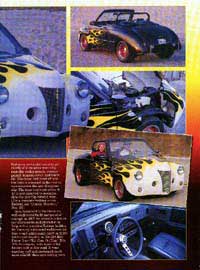
The original Rodster met most of Caroselli's criteria in that it is comparatively easy to build and can be assembled for less than $10,000. There is no welding or fiberglassing required. The design wisely retains the SUV's doors without reskinning, the complete interior, complete suspension, drivetrain, and the windshield and its frame. The kit (Standard Conversion Kit $3,995: Complete Conversion Kit $5,995, which includes everything except the donor, wheels, tires, miscellaneous fasteners, and paint) consists primarily of a one-piece front clip, rear clip, rocker panels, quarter-panels, tonneau cover, and trunk lid. The donor roof is cut off and the body is trimmed in the rear to accommodate the new fiberglass clip. The front bodywork of the S-10 is also removed to accommodate the new flip-forward nose. (For a complete buildup on the Rodster, see "Cruisin' Machine." Nov. '97).
As a testament to the Rodster's well-engineered build and proof of concept, in 1997 we literally rolled up our shirtsleeves and pitched in to help with a complete Rodster buildup for the story mentioned earlier -- a car that would additionally carry us 2,250 miles cross-country on the Hot Rod Power Tour ("Kit Cars On Tour." Nov. '97), in company with some of the hottest rods on the road. It went together well and performed much more reliably than cars costing more than twice the $12,160 it took us to build our splashy, eye-magnet Power Tour machine.
As friendly and fun as the Rodster is, its success has relied on lots of marketing and lots of sales talk, mostly because folks don't recognize it as a familiar shape. The history of the kit car business is littered with original design cars that would have been, because the overall kit buying audience seems to prefer replicas or vehicles that have the feel of an era, if only marginally faithful in design. The success of the Rodster has been attributed to guys who get the idea that the car is inexpensive to build, looks cool, and is ready to drive without a moment's hesitation, in contrast to most street rods built today.
We've said all that to say this: take a gander at the newest Rodster -- the Super Deluxe. Now, instead of the question being "What is it?" it's more like "What year is it?" That sounds like a positive to us, and a recognition that this new treatment recalls a fat-fendered car era of the late '30's, early '40's, without being just another street-rodded '40 Ford roadster. Basically, the Super Deluxe Kit is a new nose treatment that made the startling difference between the two Rodsters. If you think you see familiar shapes up front, the concept works as Henry intended. Yes, that's a '40 Ford reproduction grille and nose peak, but the rest of the front end is uniquely styled to fit the components while still offering something incredibly distinct.
The rear clip of the Rodster remains untouched, as do the donor's doors, windshield, windshield frame, interior, chassis, and drivetrain. As with the original, the front clip is a flip-forward piece, which allows great access to the engine. It is also quickly removable for those times when additional space in the engine bay is needed. The Super Deluxe is offered in a single configuration for $6,995 and includes everything necessary to build the car (including a comprehensive assembly manual) except the donor vehicle, wheels, tires, some fasteners, and paint.
About the only changes to the donor car chassis involve lowering the suspension, in keeping with the street rod looks of the car. Caroselli uses DJM lowered A-arms up front and either lowering blocks or re-arched leaf springs in the rear to lower the car 3 inches in the front and 4 inches in the back. This first Super Deluxe out of the mold received Monroe shocks and BFG rubber. The nostalgic red rims are highlighted with beauty rings and chrome shallow moon-hubcaps.
To complement the style of this first Super Deluxe, there was really only one logical paint treatment that would show off the car and shout "Look at me!" Since this Rodster would serve as Henry's marketing tool, a mirror-finish black with traditional rod flames seemed to be the best answer. Henry's crew did the body-prep work before enlisting the talents of noted rod painter Pete Santini (704/891-8895). Pete is widely recognized as a master of flame jobs, and his work on the Rodster keeps his reputation intact. Black PPG Deltron 2000 DVd urethane was used for the body, with the flames fading from Pearl White to Lemon Yellow to Tangerine, then framed by Apple Green pinstriping.
The interior is mostly stock with vinyl bucket seats, standard dash and instrument panel, and stock door panels. Since there is an abundance of donors around, changing colors or materials in the cockpit is quite easy. S-10 pickups even offer a few other possibilities for dressing up the interior. Ever the street rodder, Henry couldn't resist adding some typical rod icons to the cockpit, including a Moon tach, eight-ball shift knob, swap-meet steering wheel, and a Kenwood stereo.
To say that this new Rodster Super Deluxe is cool -- in a street rod sense -- is a giant understatement. Not only does its look rival that of today's hottest show cars, but it's ready, willing, and able to head cross-country on a whim. The bonus is that the car cost less than $10,000 to build, attracts just as much attention as pricier cars, and speaks volumes about an owner who seeks distinction in what he drives.
